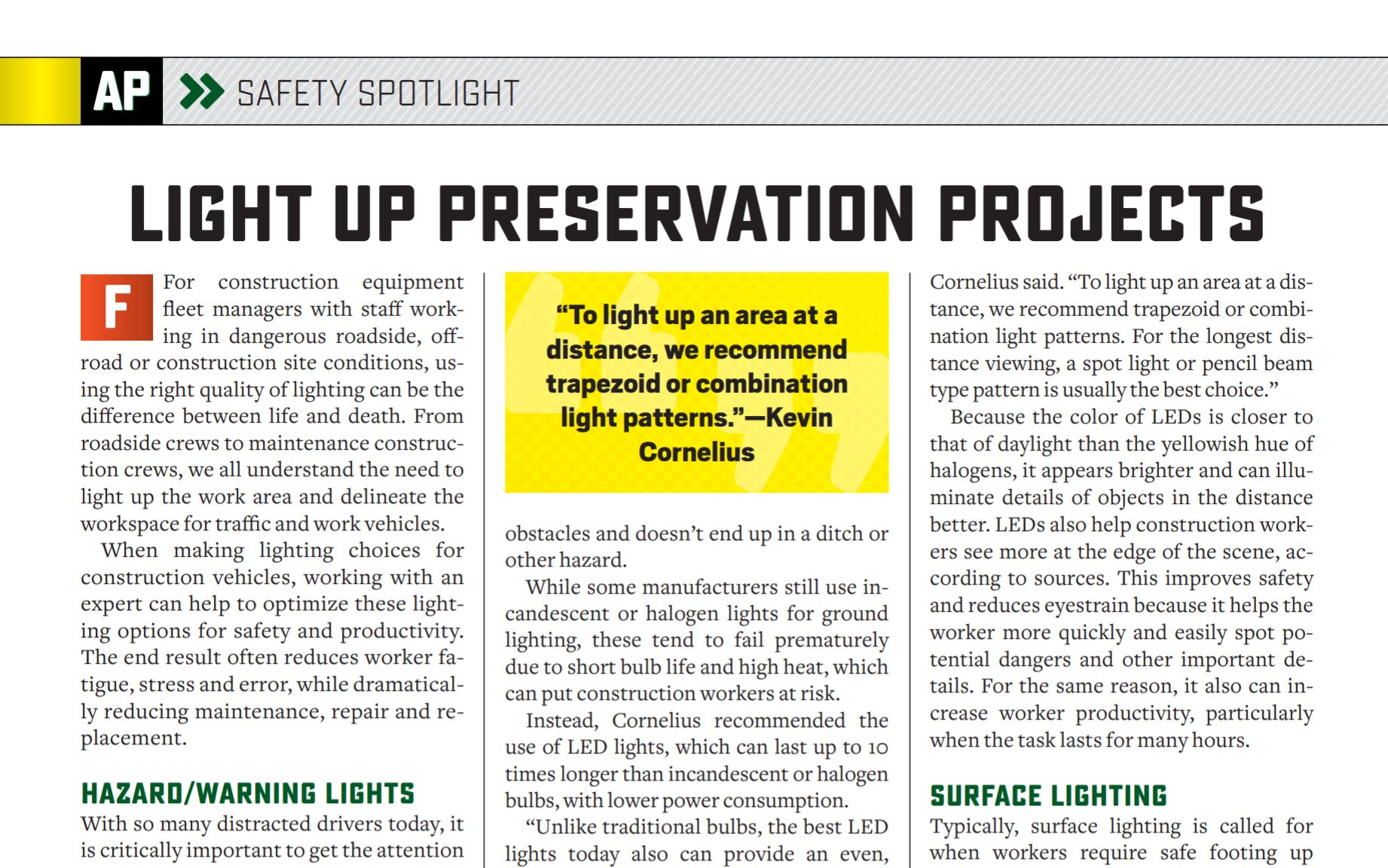4 Types of Lights to Keep Paving & Preservation Jobs Safer
BY Grote Industries

For construction equipment fleet managers with staff working in dangerous roadside, off-road or construction site conditions, using the right quality of lighting can be the difference between life and death. From roadside crews to maintenance construction crews, we all understand the need to light up the work area and delineate the workspace for traffic and work vehicles.
When making lighting choices for construction vehicles, working with an expert can help to optimize these lighting options for safety and productivity. The end result often reduces worker fatigue, stress and error, while dramatically reducing maintenance, repair and replacement.
Hazard/Warning Lights
With so many distracted drivers today, it is critically important to get the attention of nearby drivers to protect any construction workers that could be in harm’s way.
Typically, SAE Class 2 warning lights are used for construction vehicles that work along roadsides, while Class 1 warning lights (with four times the intensity of Class 2 lights) are used for emergency vehicles such as fire, police and ambulance. A variety of colors are also used, such as red for emergency vehicles and amber for vehicles that obstruct or impede traffic.
“To alert other drivers, when service vehicles may unexpectedly stop, turn or move out of regular traffic flow, it is easy to incorporate strobe lights in hideaway areas such as in headlamp, tail, turn or back-up lamps that do not require additional mounting,” said Kevin Cornelius, global marketing manager—trailer and body builders at Grote Industries. “Beacons or bar strobes can also be added. There are many options.”
Ground Lighting
When upfitted construction vehicles have to drive or back up over uncertain terrain at night—sometimes in complete blackness—it is crucial to have good ground lighting, so the vehicle can safely navigate obstacles and doesn’t end up in a ditch or other hazard.
While some manufacturers still use incandescent or halogen lights for ground lighting, these tend to fail prematurely due to short bulb life and high heat, which can put construction workers at risk.
Instead, Cornelius recommended the use of LED lights, which can last up to 10 times longer than incandescent or halogen bulbs, with lower power consumption.
“Unlike traditional bulbs, the best LED lights today also can provide an even, high-quality white light color that is easier on the eyes and provides a contrast similar to natural sunlight for better visibility,” Cornelius said.
All ground lights should also be mounted below the vehicle shining downward, typically at a –40 degree inclination, so the actual light source is not visible to the construction vehicle driver or others on the scene. “You don’t want to directly view the light source providing the ground lighting, or it can dilate your pupils, so your eyes are no longer adjusted for nighttime viewing,” Cornelius explained.
Scene Lighting
Scene lighting is used when high-powered, long-range illumination is required from a construction vehicle, and usually takes the form of work lamps. Again, LEDs are often used. This can help to eliminate stumbles, trips, falls and work-related errors due to poor visibility. However, there are different types of construction scene lighting, some of which are better suited for specific tasks.
ILLUMAGEAR’s Halo Light Improves Illumination on the Job Site
“When construction work area lights are used on the rear of the vehicle, flood or wide flood LED lights cover the broadest area,” Cornelius said. “To light up an area at a distance, we recommend trapezoid or combination light patterns. For the longest distance viewing, a spot light or pencil beam type pattern is usually the best choice.”
Because the color of LEDs is closer to that of daylight than the yellowish hue of halogens, it appears brighter and can illuminate details of objects in the distance better. LEDs also help construction workers see more at the edge of the scene, according to sources. This improves safety and reduces eyestrain because it helps the worker more quickly and easily spot potential dangers and other important details. For the same reason, it also can increase worker productivity, particularly when the task lasts for many hours.
Surface Lighting
Typically, surface lighting is called for when workers require safe footing up steps or quick access to construction tools, equipment, and materials in compartments, truck beds, and cargo areas.
While this can be accomplished by mounting LED lamps on the side of steps, or at the ends of compartments, an increasingly popular alternative is to install LED light strips wherever needed. Advances in thin-film LED technology not only produce brighter illumination, but do so using paper-thin, ultra-light strips that can be installed into the existing lighting power system.
The most rugged are resistant to damage from impacts, waterproof, able to withstand pressure washing with hot water, and resistant to the most common chemicals associated with vehicles in the event of exposure or spills. Installation usually involves peeling off doubled-sided tape and pressing the LED strips into place.
The bottom line is that any construction vehicle fleet manager can create a safer, more productive lit environment for the staff working in the field. Those who consult with a lighting specialist can not only optimize such choices, but also save on maintenance, repair and replacement over the service life of the vehicle fleet.
